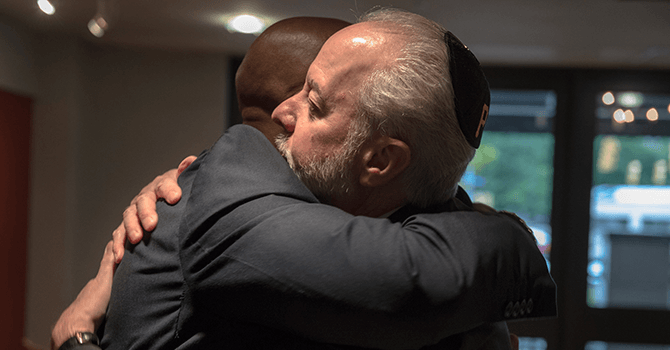Preaching the gospel without rancor toward Judaism and without words that do violence to Jews is a sacred obligation at any time of the liturgical year. But it’s especially important during Holy Week, once the most dangerous time for Jews.
Congregational leaders have a duty to make congregants aware of the history and to take care not to reinforce anti-Jewish tropes and stereotypes. To do less during this time of resurgent antisemitism and insecurity for Jews is to risk perpetuating anti-Jewish hate.
In December 2022, the Council of Centers on Jewish-Christian Relations, of which I am a member, released “A National Reckoning of the Soul: A Call to the Churches of the United States to Confront the Crisis of Antisemitism.”
I draw attention to these sentences in particular:
At this crucial time, as in the past, there is a danger that preachers and teachers might inadvertently reinforce an image of Jesus as “outside” Judaism — or worse: as somehow opposed to the spiritual traditions of his own people. This could leave Christian congregations susceptible to the divisive anti-Jewish propaganda echoing all around them.
I underscore the word “inadvertently” because it points to both the progress that has been made and the work that is yet to be done in Jewish-Christian reconciliation.
Liturgy is an intensely intimate, communal experience. As such, it is an area into which inadvertent anti-Judaism and antisemitism can seep. The power of liturgical cycles — in proclamation, ritual, sacrament, environment and music — can subtly reinforce messages we may not intend to send.
I offer 10 suggestions here, drawn from years of dialogue with Christian and Jewish scholars whose work is focused on renewing the relationships between Jews and Christians.
1. Know the history. As you prepare to preach, remember that Holy Week has historically been the most dangerous week of the year for Jews. In the Middle Ages, Christians were incited to violence against Jews. Laws prevented Jews from leaving their homes, either to guard against so-called Jewish desecration of Christian faith or to protect Jews from Christian violence to “save” them for the end of days. As the council’s statement stresses, “a focus on historical accuracy highlights the Jewish identity of Jesus.”
2. Know your denomination’s statements regarding repentance toward Jews and Judaism. There are many excellent statements, but few are widely known. For a start, consult Franklin Sherman’s excellent two-volume collection “Bridges: Documents of the Christian-Jewish Dialogue.”
3. Preach clearly and consistently that Jesus and his followers were practicing Jews of Second Temple Judaism. It is important to avoid preaching and teaching in terms of “us” versus “them” as if Christianity were a fully developed religion during Jesus’ last days.
4. In your messages, reinforce the rich diversity of Jewish life at the time of Jesus. The Jesus movement was one way of discerning the best (Jewish) way to be in relationship with God.
During the Easter season, Sunday readings focus on the early community and so-called birth of the church. Too often, I hear sermons that deploy the sometimes harsh rhetoric of New Testament passages as if it were a developed doctrinal stance of the churches toward Jews and Judaism at that time. Explain, instead, that these passages reflect intra-Jewish debates of the first century.
5. Examine our beloved hymnody and excise supersessionism. Christian triumphalism is often embedded in our hymns, and it is a key way that anti-Judaism slips inadvertently into our worship. This Boston College website includes revised lyrics for the hymns “Lift High the Cross” and “Lord of the Dance,” as well as other resources for Lent and Holy Week.
6. Do not let the liturgical environment and use of Scripture implicitly send the wrong message. Traditional Christian anti-Jewish tropes use Scripture to accuse Jews of stubborn willful ignorance, of deep-rooted deceitfulness as children of the devil (John 8:44-45), and of obdurate refusal to recognize Jesus as the Messiah and the truth of their own Scripture.
If your congregation practices Easter vigil rituals that employ physical motifs of moving from darkness to light and proclaim a cycle of Scripture readings to present an arc of salvation history, proceed carefully in your preaching. Make sure to avoid associating darkness with anti-Jewish tropes and the vigil movement to light with a triumphalist interpretation of the New Testament that allows for only a christological interpretation of the Hebrew Bible.
Emphasize that Jesus prayed and quoted the Torah and the Prophets and that, as set out in the Pontifical Biblical Commission’s “The Jewish People and Their Sacred Scriptures in the Christian Bible,” Christians must respect Jewish interpretation of the Hebrew Bible.
7. Do not reinforce the dangerous deicide and blood curse (Matthew 27:25) accusations that have prompted violence against Jews for millennia. Whether in recitations of the passion narrative or in dramatic representations, make a point to denounce the dangerous and false accusation that all Jews everywhere and at all times are responsible for the death of Christ and therefore deserving of brutal punishment. Rome executed Jesus.
8. Do not co-opt Jewish ritual. In genuine efforts to understand the Jewish roots of Christianity, some congregations hold Christian Seders, even assigning christological symbolism to Seder symbols.
Instead, if your congregation wishes to understand Judaism as a source of Christian spirituality, invite a local rabbi and synagogue members to have a conversation with your congregants; explore both religions’ spring holy days of freedom and liberation. Alternatively, both congregations might plan an instructional Seder together.
9. Do not preach that the Jews have lost their covenant with God. Christian preaching is not a zero-sum game of one-upmanship. Christians can celebrate and learn from Jewish faithfulness to the covenant, rejoicing that with Easter, they too share in God’s covenant.
10. Commit to preaching or teaching not a single word about Christian salvation that could not be said in the presence of a member of the Tree of Life synagogue or a child standing before the gas chambers of Auschwitz.
Preach the good news of the risen Christ — but not by denigrating Judaism.
Want to learn more?
Preaching and teaching
Council of Centers on Jewish-Christian Relations
Four-part video series: “Presenting the Passion … Without Blaming ‘the Jews’”
“Preaching and Teaching ‘With Love and Respect for the Jewish People.’”
Difficult Texts: The Passion Narratives and the Crucifixion
History
“The Eastertide Stoning of the Jews and Its Liturgical Echoes”
Why Good Friday was dangerous for Jews in the Middle Ages and how that changed
Judaism and Christian spirituality
“Has God Only One Blessing?: Judaism as a Source of Christian Self-Understanding”
“The Jewish People and their Sacred Scriptures in the Christian Bible”
Editor's note: This article has been translated into German.

































